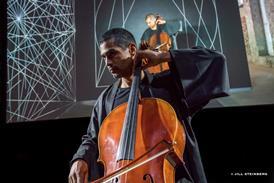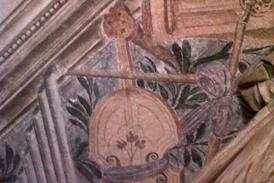Composer Anselm McDonnell writes about curating a concert for multiple violins that pushes the boundaries of traditional tuning and intonation

Discover more Featured Stories like this in The Strad Playing Hub
The Expanded Violin is a programme focused on modern trends in violin writing. It explores repertoire for violin and electronics, pieces for multiple violins, and investigates minute intervals through microtonality. The concert is my second curated event with the London Symphony Orchestra through the Jerwood Composer+ Scheme, and takes place at LSO St Luke’s at 7pm on 12 October 2024.
Out of current trends in contemporary string writing, the one I find most fascinating, and that is fast becoming widespread, is microtonality. Questions of intonation, tuning and minute detail have always been a part of string pedagogy, but not necessarily of concern for composers, but in microtonality these questions become prominent parts of the creative process. Microtonality is often used as an umbrella term for music that uses intervals smaller than a semitone or employs a tuning system other than 12-tone equal temperament, which is the predominant tuning system used in Western genres, including classical music.
Bowed stringed instruments are well suited to various tuning systems because they are not locked into a set tuning by frets, and the aural precision of tuning to other players in an orchestra/string section setting means performers are already trained to pay attention to miniscule details of intonation. My own two pieces on the programme explore the rich harmonies and sonorities available to the violin through microtonality.
Rusted Sugar, commissioned by Larissa O’Grady, is written in 24 equal divisions of the octave (24 EDO), a system that adds notes between each semitone, resulting in intervals called quarter tones. For a string player this requires precision, but if you can play a semitone, it is not too far a step to find and physically learn the location of the note in between, especially at the low end of the fingerboard where notes are further apart.
Chords tuned in just intonation noticeably drift further away from equal temperament as more notes are added. These chords have a different quality to their equal-temperament cousins: some become very smooth, others agitated and fuzzy
My second piece, Genesis Cradle, commissioned by the LSO for Mira Benjamin, uses a tuning system called just intonation, as do the two pieces by Chiyoko Szlavnics. Unlike equal temperament, intervals in this system are not always the same size but are tuned to the distances that arise naturally in the harmonic series. For example, in just intonation, the first major third is a little lower than the one you’d hear on the piano. While this may not sound like a huge difference, chords tuned in just intonation noticeably drift further away from equal temperament as more notes are added. These chords have a different quality to their equal-temperament cousins: some become very smooth, others agitated and fuzzy.
For just intonation, the process of tuning each note requires detailed listening. With practice, a performer can learn to recognise the beating patterns and quality of different intervals, which are indicated in the score by fractions. While this may initially appear quite daunting, it is surprising how quickly you can adjust to hearing the difference. After working on Genesis Cradle for about a month, my equally tempered piano started sounding very unusual to me!

Despite the widespread use of just intonation in music of other cultures, the fact that most synthesised electronic instruments (including orchestral sample libraries) are designed for the creation of equal temperament music means other tuning systems can feel unfamiliar to Western ears. Film and game music, along with most popular electronic genres, are created with these tools. The most difficult issue I faced in composing was not using microtones on the violin but getting an electronic synthesiser to use these systems. This lack of familiarity often means that microtonal music in classical contexts leans towards a meditative aesthetic that encourages listeners to rediscover and hear the beauty of microtonal harmonies.
When choosing repertoire for the concert, I selected pieces that foster an atmosphere of unhurried time and space, either for the contemplation of emotional responses (such as the two In Memoriam pieces by Saariaho and Aho), or submersion in a world of slowly changing harmonies (Chadburn’s De La Salle). The concert atmosphere will be a space for deep listening, for audiences to become absorbed in the rich sound worlds of each piece.
The rehearsal process for each composition on the programme will be quite different, as they have their own unique challenges. For the three pieces using electronics, performers need to follow a timer so they can sync with the backing track, as well as listening closely to the synthesised harmonies they will hear back on monitors. In the two duos by Szlavnics, players instead must tune to each other, and these pieces explore a limited and precise harmonic space full of small, detailed movements and glissandi. Violin quartets such as Wilson’s Primavera require a different kind of listening, as each player moves rapidly through the texture in a way that is not as pronounced in string quartet playing. The harmony and rhythmic writing is very close-knit and requires intense concentration and responsiveness to perform this light and agile music.
The Expanded Violin, curated by Anselm McDonnell, takes place at 7pm on 12 October 2024 at LSO St Luke’s, London, UK.
Read: Extended and splendid: 4 techniques for bowed strings to get the creative cogs turning
Read: In search of sounds: contemporary violin techniques with Sarah Saviet
Discover more Featured Stories like this in The Strad Playing Hub
The number one source for playing and teaching books, guides, CDs, calendars and back issues of the magazine.
In The Best of Technique you’ll discover the top playing tips of the world’s leading string players and teachers. It’s packed full of exercises for students, plus examples from the standard repertoire to show you how to integrate the technique into your playing.
The Strad’s Masterclass series brings together the finest string players with some of the greatest string works ever written. Always one of our most popular sections, Masterclass has been an invaluable aid to aspiring soloists, chamber musicians and string teachers since the 1990s.
The Canada Council of the Arts’ Musical Instrument Bank is 40 years old in 2025. This year’s calendar celebrates some its treasures, including four instruments by Antonio Stradivari and priceless works by Montagnana, Gagliano, Pressenda and David Tecchler.






































No comments yet